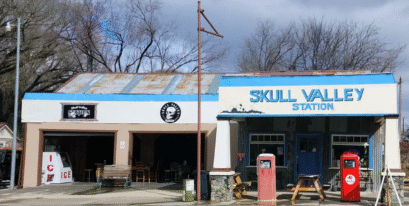HOW DID Skull Valley, AZ, GET its NAME?
 It is best told by Will C. Barnes in his book, “Arizona Place Names,” in which he said, ‘There is documentation to demonstrate that the name Skull Valley dates back to at least 1864 when the first gubernatorial party arrived in the future Prescott. There were several severe battles with Indians after the arrival of white men in Skull Valley.
It is best told by Will C. Barnes in his book, “Arizona Place Names,” in which he said, ‘There is documentation to demonstrate that the name Skull Valley dates back to at least 1864 when the first gubernatorial party arrived in the future Prescott. There were several severe battles with Indians after the arrival of white men in Skull Valley.
Bones greeted travelers along the path through this valley following a massacre in the 1800s. The abundance of skulls was described by some as the result of a battle between Indian tribes, while another story attributed the skulls to white men who were murdered by hostile Indians. Another skirmish between explorers and natives in the 1860s led to the deaths of dozens of Indians, who were left where they fell without being buried.
Soldiers from Captain Hargraves’ company of the First California Volunteers escorting Coles Bashford came through this valley southwest of Prescott in 1864 found piles of bleached skulls of Indians indicating a fierce battle had been fought here. Most likely they Yavapai or Tonto Apache against Maricopa or Pima. It appeared to them the latter came out the victors.
Camp Skull Valley was established here on April 10, 1866 to protect settlers and travelers on the La Paz, (near today’s Ehrenberg) and Prescott road. The site was badly placed and in May, 1867 it was moved back to Camp Date Creek, 50 miles southwest of Prescott.
Another battle took place here on August 12, 1866 between four civilians and four soldiers against more than a hundred Indians. One of them went for help and more soldiers arrived. During a parley the natives claimed all the grass and water belonged to them. A battle ensued and when the smoke cleared, 23 Indians were dead. Several more were found in the area.
However, the name actually derives from the fact that the first white men who entered Skull Valley found piles of bleached Indian skulls. The skulls were the remains of a bitter battle between Apaches and Maricopas. The dead were left where they fell. At least 35 more skulls were added to the bleaching bones as a result of a fight on August 12, 1866, in which six freighters, five citizens, and four soldiers battled more than 100 Indians.” This ladder battle occurred near Grape Vine Springs on the West side of Skull Valley.
